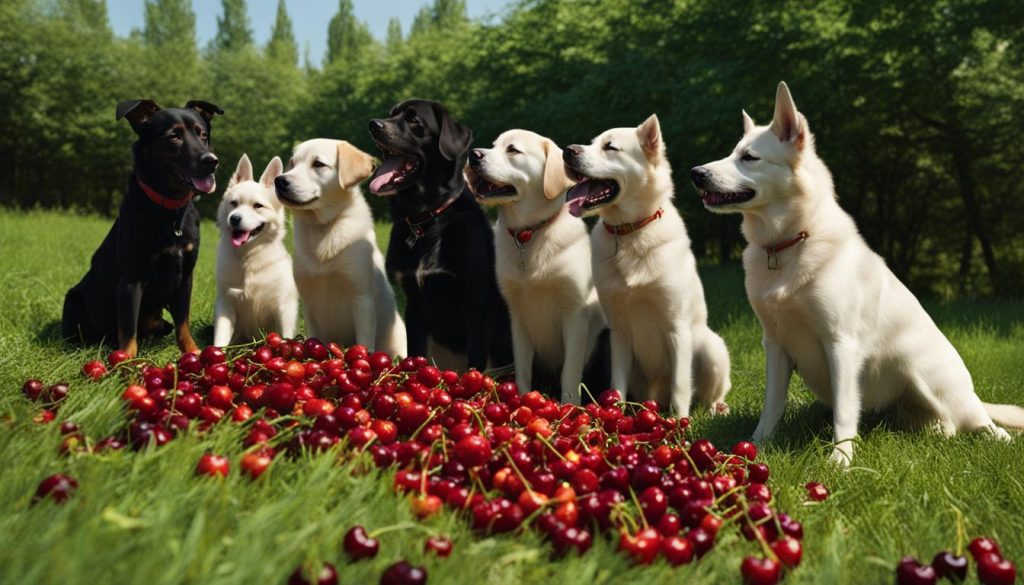Welcome to our comprehensive guide on whether dogs can safely consume cherries. As a responsible dog owner, it’s essential to be aware of the potential risks and benefits associated with feeding cherries to your furry friend. In this article, I will discuss the dangers of cherry pits, the symptoms of cyanide poisoning, whether unprocessed cherries are safe, the health benefits of cherries, and the risks involved. Additionally, I will provide safe alternatives and tips on serving cherries to dogs.
Key Takeaways:
- Cherry pits, stems, and leaves contain cyanide, which can be toxic and potentially lethal for dogs.
- Ingesting cherry pits can also lead to intestinal blockages in dogs.
- Symptoms of cyanide poisoning in dogs include labored breathing, bright red gums, and dilated pupils.
- Unprocessed cherries can be safely consumed by dogs, but caution must be exercised, and the pits, stems, and leaves must be removed.
- Cherries contain antioxidants, melatonin, vitamin A, vitamin C, and fiber, but the risks associated with cherry pits outweigh the benefits.
The Dangers of Cherry Pits for Dogs

When it comes to sharing cherries with your furry friend, it’s important to be aware of the potential dangers associated with cherry pits. These small, hard seeds contain cyanide, a toxic substance that can be harmful to dogs if ingested in large quantities. Cyanide poisoning can lead to symptoms such as labored breathing, bright red gums, and dilated pupils.
Ingesting cherry pits can also pose a risk of intestinal blockages in dogs. These blockages can cause severe discomfort and may require veterinary intervention to resolve. To prevent these issues, it’s crucial to prevent dogs from accessing cherry pits or spit them out if accidentally consumed.
“Cherry pits contain cyanide, which can be harmful to dogs when ingested in large quantities.”
It’s important to exercise caution when offering cherries to your dog and ensure that they are thoroughly washed and free from pits, stems, and leaves before feeding. Remember to always cut cherries into small, bite-sized pieces to reduce the risk of choking, especially for smaller dog breeds. While cherries can provide some nutritional benefits for dogs, the potential risks associated with cherry pits make it crucial to approach them with caution.
| Dangers of Cherry Pits for Dogs |
|---|
| Cyanide poisoning |
| Intestinal blockages |
| Risk of choking |
| Labored breathing |
| Bright red gums |
| Dilated pupils |
While it’s natural to want to share tasty treats with our canine companions, it’s essential to prioritize their safety and well-being. Consulting with a veterinarian before introducing any new foods into a dog’s diet, including cherries, is always recommended. Your vet can provide guidance based on your dog’s specific needs and help you make informed decisions about feeding fruits and other human foods to your furry friend.
Potential Symptoms of Cyanide Poisoning in Dogs

Dogs that have ingested multiple cherries without pits may exhibit symptoms of cyanide poisoning. It is important to be aware of these symptoms and take immediate action if necessary. Here are some common signs of cyanide poisoning in dogs:
Labored Breathing
Dogs experiencing cyanide poisoning may have difficulty breathing. They may appear to be panting heavily or struggling to catch their breath. Labored breathing is a serious symptom that should never be ignored.
Bright Red Gums
Another sign of cyanide poisoning is bright red gums. If you notice that your dog’s gum color has become unusually vibrant, it could indicate a potential toxicity issue. Keep a close eye on their gum color and seek veterinary assistance if necessary.
Dilated Pupils
When dogs are exposed to cyanide, their pupils may become dilated, appearing larger than usual. This can be a sign of poisoning and should be taken seriously. If your dog’s pupils are consistently dilated, contact your veterinarian for guidance.
“It is crucial to monitor your dog for any symptoms of cyanide poisoning, especially if they have consumed cherries without pits. Prompt veterinary attention can be lifesaving in these situations.”
Remember, if your dog exhibits any of these symptoms after consuming cherries, it is important to act quickly. Contact your veterinarian or a pet poison control hotline for guidance. Always prioritize your dog’s safety and well-being.
| Symptoms of Cyanide Poisoning in Dogs | Action |
|---|---|
| Labored Breathing | Seek veterinary assistance immediately |
| Bright Red Gums | Contact your veterinarian for guidance |
| Dilated Pupils | Monitor closely and seek veterinary attention if necessary |
Can Dogs Eat Unprocessed Cherries?

Dogs can enjoy unprocessed cherries as a treat, but it’s crucial to take certain precautions to ensure their safety. Please be aware that the pits, stems, and leaves of cherries contain cyanide, which can be harmful to dogs if ingested.
To safely feed cherries to dogs, it is vital to remove all pits, stems, and leaves before offering them. These parts of the cherry can pose a choking hazard or lead to intestinal blockages. Additionally, thoroughly wash the cherries to remove any pesticides or other harmful substances that may be present.
When feeding cherries to dogs, it’s essential to exercise moderation. Too many cherries can upset a dog’s stomach due to their high sugar content. It’s advisable to only offer cherries as a small portion of a dog’s overall diet, typically around 10%.
| Benefits | Risks |
|---|---|
| Cherries are a good source of antioxidants, melatonin, vitamin A, vitamin C, and fiber, which can provide certain health benefits to dogs. | The pits, stems, and leaves of cherries contain cyanide, which can be toxic to dogs when ingested. Cherries also have a high sugar content, which can lead to an upset stomach and contribute to health issues like diabetes and obesity. |
Overall, while dogs can enjoy unprocessed cherries, it is important to use caution and follow proper guidelines. Consulting with a veterinarian is recommended before introducing any new foods into a dog’s diet to ensure their safety and well-being.
Health Benefits of Cherries for Dogs

Fresh cherries not only have a delicious taste but also offer potential health benefits for dogs. They are packed with essential nutrients and antioxidants that can support overall well-being. Here are some of the potential health benefits of cherries for dogs:
- Antioxidants: Cherries contain antioxidants that help protect cells from damage caused by harmful molecules called free radicals. These antioxidants can support a healthy immune system in dogs.
- Melatonin: Cherries naturally contain melatonin, a hormone that regulates sleep-wake cycles. In dogs, melatonin may have a calming effect and help with anxiety or insomnia.
- Vitamin A: Cherries are a good source of vitamin A, which is essential for maintaining healthy vision, immune function, and skin health in dogs.
- Vitamin C: Cherries also provide a dose of vitamin C, which plays a vital role in collagen production, immune support, and antioxidant activity.
- Fiber: The fiber content in cherries can promote healthy digestion and regular bowel movements in dogs.
While these benefits are promising, the potential risks associated with cherry pits, stems, and leaves containing cyanide should be taken into consideration. Always consult with a veterinarian before incorporating cherries into your dog’s diet and ensure that any cherries fed to them are thoroughly washed and free of pits, stems, and leaves.
Possible health benefits of cherries in dogs:
| Nutrient | Potential Benefits |
|---|---|
| Antioxidants | Supports a healthy immune system |
| Melatonin | May have a calming effect |
| Vitamin A | Maintains healthy vision, immune function, and skin health |
| Vitamin C | Plays a vital role in collagen production, immune support, and antioxidant activity |
| Fiber | Promotes healthy digestion and regular bowel movements |
Risks of Feeding Cherries to Dogs

When it comes to cherries, caution is key when considering them as a treat for your furry friend. While dogs can technically eat unprocessed cherries, it’s important to be aware of the potential risks involved. One significant risk is the high sugar content in cherries, which can lead to an upset stomach in dogs. Feeding dogs excessive amounts of sugar over time can also contribute to health issues such as diabetes and obesity.
However, the main concern when it comes to cherries and dogs is the presence of cyanide in the pits, stems, and leaves. Cyanide is a toxic substance that can be harmful and even lethal to dogs if ingested in large quantities. It’s crucial to keep cherry pits and any other parts of the cherry plant out of your dog’s reach to prevent accidental ingestion.
Please be aware that the risks associated with cherries mainly lie in the pits, stems, and leaves. Fresh, unprocessed cherries themselves can offer some health benefits for dogs, including antioxidants, melatonin, vitamin A, vitamin C, and fiber. However, the potential benefits of these nutrients may not outweigh the risks associated with the cyanide-containing parts of the cherry.
Potential Risks of Feeding Cherries to Dogs:
- High sugar content can cause an upset stomach and contribute to health issues like diabetes and obesity
- Pits, stems, and leaves contain cyanide, posing a significant risk to dogs’ health
- Ingesting cherry pits can lead to intestinal blockages, requiring veterinary intervention
Considering the potential risks involved, it’s best to exercise caution when it comes to feeding cherries to your dog. If you decide to offer cherries as a treat, make sure they are fresh, unprocessed, and thoroughly washed. Remove the pits, stems, and leaves before serving, and consider cutting the cherries into small pieces to minimize choking hazards and reduce the risk of intestinal blockages.
Remember, cherries should only make up a small portion of your dog’s diet, typically around 10%. The majority of their nutrition should come from a well-balanced dog food diet. It’s important to monitor your dog for any adverse reactions or symptoms after consuming cherries and seek veterinary assistance if necessary.
Safe Alternatives to Cherries for Dogs
While cherries should be approached with caution, there are several other fruits and berries that are safe and beneficial for dogs to consume. These alternatives provide similar nutrients without the potential risks associated with cherries. Here are some safe fruits that dogs can eat:
- Blueberries: Blueberries are a great source of antioxidants and can help boost a dog’s immune system.
- Mangoes: Peeled and pitted mangoes can be a tasty treat for dogs. They contain vitamins A, C, and E, which promote good eye health and boost the immune system.
- Apples: Apples without the core and seeds can be a refreshing and nutritious snack for dogs. They are a good source of fiber and vitamin C.
It is important to remember that moderation is key when introducing any new foods to your dog’s diet. Start by offering small amounts of these fruits as a treat and monitor your dog for any adverse reactions. If your dog has any underlying health conditions or allergies, it is always best to consult with a veterinarian before making any changes to their diet.
By offering these safe alternatives, you can provide your dog with a variety of flavors and nutrients while ensuring their well-being. Remember to always prioritize your dog’s health and consult with a professional if you have any concerns or questions.
| Fruit | Nutritional Benefits |
|---|---|
| Blueberries | Rich in antioxidants and can boost the immune system. |
| Mangoes | Contain vitamins A, C, and E, which promote good eye health and boost the immune system. |
| Apples | A good source of fiber and vitamin C. |
Serving Cherries to Dogs Safely

If you decide to serve cherries to your dog, it is crucial to take the appropriate steps to ensure their safety. Follow these guidelines to serve cherries to dogs safely:
- Choose fresh, unprocessed cherries: Opt for fresh cherries that have not been processed or preserved. Avoid canned cherries or those that have been soaked in syrup.
- Thoroughly wash the cherries: Rinse the cherries thoroughly under running water to remove any dirt, pesticides, or other contaminants.
- Remove pits, stems, and leaves: Cherry pits, stems, and leaves contain cyanide and can be dangerous for dogs. Make sure to remove all these parts before serving cherries to your dog.
- Cut cherries into small pieces: For smaller dog breeds, it’s best to cut cherries into smaller, bite-sized pieces to prevent choking hazards and reduce the risk of intestinal blockages.
By following these safety tips, you can minimize the potential risks associated with feeding cherries to dogs.
Table: Recommended Serving Guidelines for Dogs
| Dog Size | Cherries per Serving |
|---|---|
| Small (up to 20 lbs) | 1-2 cherries |
| Medium (20 – 50 lbs) | 2-4 cherries |
| Large (50+ lbs) | 4-6 cherries |
Remember, cherries should only make up a small portion of your dog’s diet, typically around 10%. The majority of their nutrition should come from a well-balanced dog food diet. It’s always important to monitor your dog for any adverse reactions or symptoms after consuming cherries and seek veterinary assistance if necessary.
Moderation and Monitoring
When it comes to feeding cherries to dogs, moderation and monitoring are key. While cherries may offer some health benefits, it is important to be aware of the potential dangers they pose to our furry friends. The presence of cyanide in cherry pits, stems, and leaves can be toxic to dogs, making it crucial to exercise caution.
It is recommended that cherries make up only a small portion, approximately 10%, of a dog’s diet. The majority of their nutrition should come from a well-balanced dog food diet. By limiting the amount of cherries they consume, we can minimize the risk of cyanide poisoning or intestinal blockages.
In addition to moderation, it is essential to monitor dogs for any adverse reactions or symptoms after consuming cherries. If a dog exhibits symptoms such as labored breathing, bright red gums, or dilated pupils, it is important to seek veterinary assistance immediately. Timely intervention can make all the difference in ensuring the well-being and safety of our furry companions.
| Key Points | Dangers | Risks |
|---|---|---|
| Cherries contain cyanide in their pits, stems, and leaves | Can be toxic and potentially lethal | High sugar content can lead to upset stomach, diabetes, and obesity |
| Moderation is crucial | Symptoms of cyanide poisoning include labored breathing, bright red gums, and dilated pupils | Presence of cyanide poses a significant risk to dogs |
| Monitor dogs for any adverse reactions | Ingesting cherry pits can cause intestinal blockages | Consult with a veterinarian before incorporating cherries into a dog’s diet |
While cherries may seem like a tempting treat for our four-legged companions, it is crucial to approach them with caution. By practicing moderation, monitoring for symptoms, and consulting with a veterinarian, we can ensure the well-being and safety of our canine friends. Remember, their health should always be our top priority.
Wrapping Up
To summarize, when it comes to dogs and cherries, caution must be exercised to ensure their safety. While dogs can technically eat unprocessed cherries, it is important to remember the potential risks associated with cherry pits, stems, and leaves. These parts contain cyanide, which can be harmful and even lethal to dogs if ingested in large quantities.
Although fresh cherries do offer some health benefits for dogs, such as antioxidants, melatonin, vitamin A, vitamin C, and fiber, it is crucial to balance these potential benefits with the potential risks. The high sugar content in cherries can also contribute to upset stomachs, diabetes, and obesity in dogs if consumed excessively over time.
Ultimately, it is advisable to consult with a veterinarian before introducing cherries or any new food into a dog’s diet. They can provide personalized guidance and recommendations based on a dog’s specific needs and health conditions. It is always better to be safe than sorry when it comes to the well-being of our furry friends.
FAQ
Can dogs eat cherries?
Dogs can technically eat unprocessed cherries, but precautions must be taken to ensure their safety. The pits, stems, and leaves of cherries contain cyanide, which can be toxic and potentially lethal for dogs. It is important to remove these parts before feeding cherries to dogs.
Are cherries safe for dogs?
While cherries can provide some health benefits for dogs, such as antioxidants and fiber, the potential risks associated with cherry pits, stems, and leaves make them a less than ideal treat. It is important to consult with a veterinarian before incorporating cherries into a dog’s diet.
What are the dangers of cherry pits for dogs?
Cherry pits contain cyanide, which can be harmful to dogs when ingested in large quantities. Cyanide poisoning can cause symptoms such as labored breathing, bright red gums, and dilated pupils. Ingesting cherry pits can also lead to intestinal blockages, requiring veterinary intervention.
What are the potential symptoms of cyanide poisoning in dogs?
Dogs that have ingested multiple cherries without pits may exhibit symptoms of cyanide poisoning, including labored breathing, bright red gums, and dilated pupils. It is important to monitor dogs for these signs and seek veterinary assistance if necessary.
Can dogs eat unprocessed cherries?
Dogs can safely consume unprocessed cherries, but precautions must be taken. Cherries should be thoroughly washed, and the pits, stems, and leaves must be removed before feeding them to dogs. It is essential to use extreme caution and keep cherries that have not been pitted out of reach of dogs.
What are the health benefits of cherries for dogs?
Fresh cherries contain antioxidants, melatonin, vitamin A, vitamin C, and fiber, which can provide some health benefits for dogs. However, the potential risks associated with cherry pits, stems, and leaves may outweigh these benefits.
What are the risks of feeding cherries to dogs?
Cherries have a high sugar content, which can lead to an upset stomach in dogs. Feeding dogs excessive amounts of sugar over time can contribute to health issues such as diabetes and obesity. Additionally, the presence of cyanide in cherry pits, stems, and leaves poses a significant risk to dogs’ health and should be avoided.
What are safe alternatives to cherries for dogs?
Blueberries, peeled and pitted mangoes, and apples without the core and seeds are healthier alternatives to cherries that can provide similar nutrients without the potential risks associated with cherry pits, stems, and leaves.
How can cherries be served to dogs safely?
If feeding cherries to dogs, it is crucial to ensure they are fresh, unprocessed, and thoroughly washed. The pits, stems, and leaves must be removed before serving. It is recommended to cut cherries into small pieces, especially for smaller dog breeds, to prevent choking hazards and reduce the risk of intestinal blockages.
Should cherries be included in a dog’s diet?
Cherries should only make up a small portion of a dog’s diet, typically around 10%. The majority of a dog’s nutrition should come from a well-balanced dog food diet. It is essential to monitor dogs for any adverse reactions or symptoms after consuming cherries and seek veterinary assistance if necessary.






